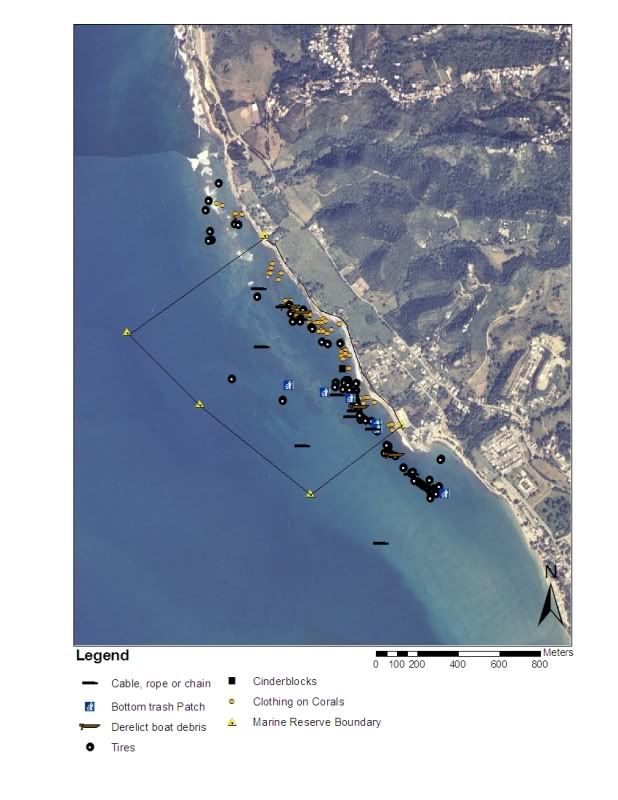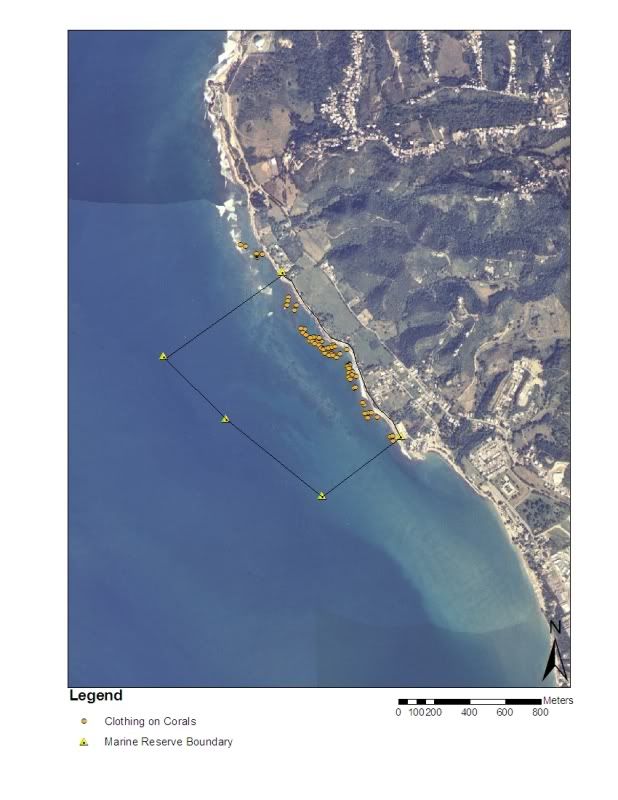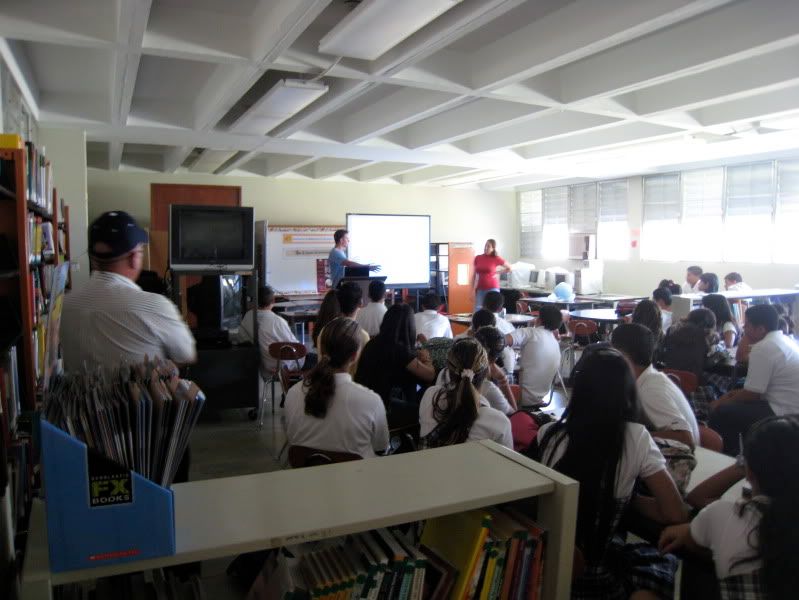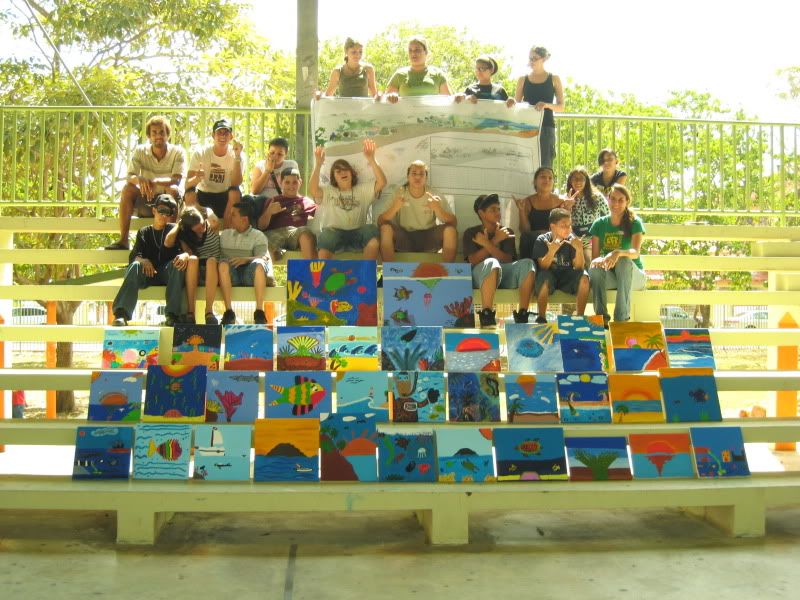Coral Reef Protection through Marine Debris Removal in Reserva Marina Tres Palmas
Project Summary
May 24th, 2009
On March 1st, 2009, the field work portion of this years concerted community effort of protecting reefs through the removal of marine debris came to a close. The field work began nearly a year ago in last June. The project objectives were to involve numerous community members, to expand our efforts outside of the Tres Palmas Marine Reserve to adjacent areas, and to inform students and the community in Rincón why it is important to protect these natural resources for generations to come. We are happy to report that all of these objectives were accomplished.
Volunteer participation was a huge success. A grand total of 130 people volunteered their time to protect and restore Rincón’s precious coral reefs. Many of these individuals represented various agencies and businesses. For instance, we had individuals help us from the Gulf of Mexico Foundation, last years project funders, individuals from our current project funders the National Oceanic Atmospheric Administration (NOAA), Puerto Rico's Department of Natural Resources, students from the University of Puerto Rico’s Department of Marine Sciences, the Municipality of Rincón, area schools, local fisherman, international businesses such as Billabong, and local businesses such as Taino Divers. This type of support, and help, was what the project aimed at to achieve. Every person, agency, and business was equally valued during their participation and were all equally as important. Thank you for all of your help.
The amount of volunteer effort allowed project orchestrators, Captain Edwin Pauco’ Font a local Rincoeño fisherman and myself (Wessley Merten) a marine science graduate student from the University of Puerto Rico's Department of Marine Sciences, to expand outside of the marine reserve in search of un-natural underwater debris. Below is an image summarizing the daily tracks run throughout the project. Tow-boarding and swimming were the principle methods used to locate the debris.

Figure 1. Using a GPS handheld device the daily project boat tracks were recorded, saved, and uploaded to a computer where the figure above was created. This was done to depict the area monitored.
Nearly two times the area of the Reserva Marine Tres Palmas (~825,558
m2) was monitored and covered. During the arduous endeavor many objects were found and removed with the help of the volunteers (See figure 2). We encourage you to browse through the project’s blog archive to the date that you helped in the field to find your photo(s).

Figure 2. Debris removed ranged from tires, corals smothered by debris (clothing, rope, fishing line), blocks, extensive areas of cable and rope, trash patches, and significant amounts of derelict boat debris.
A total of 225 tires (Figure 3) were extracted bringing the two year total to 475.

Figure 3. Tires were significantly aggregated along the nearshore shelf stretching from Calle Surf to the Black Eagle Marina. Other tires, in decreased frequency, were discovered near Steps beach and north to Marias beach.
The removal of tires is important because during large winter swell events these tires become projectiles and can easily damage the delicate and endangered Elkhorn coral (
Acropora palmata) that resides in the marine reserve and adjacent areas. Not only can tires negatively impact corals but clothing, rope, and other objects can, too. Hence, throughout our effort we also concentrated on removing these types of items from the afftected Elkhorn coral colonies. Every colony discovered (Figure 4) with growth restricting marine debris was photographed, marked with a waypoint, and relieved by carefully cutting, unraveling, and removing the debris.

Figure 4. A total of 120 corals were restored through the removal of clothing, rope, plastic bags, and fishing line within and outside of the marine reserve.
Another strenuous endeavor was the removal of over 50 cinderblocks discovered just offshore Steps beach (Figure 5).

Figure 5. Over 50 cinderblocks were removed from the marine reserve at the above location. These blocks are an un-natural type of habitat that were discovered within an intricate natural habitat. Hence, to improve the reef quality and health they were extracted.
Other items that hinder the quality and health of these reefs are extensive areas of cable, rope, and metal (Figure 6).

Figure 6. A total of 10 extensive areas of cable, rope, and metal were discovered wrapped around hard and soft corals, and preventing other bottom dwelling organisms from colonizing those areas.
Another common discovery were areas of concentrated bottom debris such as plastic bottles and bags, plastic forks and spoons, shoes, clothing, cans, glass bottles, and more
(Figure 7).

Figure 7. These trash patches were usually found on the lee side of large reef formations (i.e. bank shelfs, or patch reefs) where the dominant nearshore currents concentrated the debris and then were reluctant to remove the debris once it was established there.
Lastly, areas of derelict boat debris were frequently discovered during the effort and removed (Figure 8).

Figure 8. Derelict boat debris ranged from fiberglass siding, 2x4’s, wood slates, boat frames, and yolas. There were 4 of these locations with a significant amount of the mentioned items.
The images above summarize the volunteer debris removal effort. Each item was removed by one of the 130 individuals that helped throughout this project. Every item removed, including tires, clothing, rope, etc., were removed with a sense of satisfication knowing that the effort would help improve the health and quality of the reef. But, oftentimes when these items were found, along with miscellaneous objects such as car batteries, engine blocks, oil cans, gas cans, chairs, stuffed animals, and large pvc pipes feelings of dismay and sadness struck the volunteers and project coordinators. It was at these times that it was undoubtedly apparent that education and outreach towards increased reef awareness and protection needs to be a top priority in area schools and throughout the communities in order to to conserve the viability of nearshore reef ecosystems around Puerto Rico.
In effort to protect the future health and quality of the reefs in Rincón, multi-media presentations were given to local students about the severity of this problem and why we should strive to protect these precious natural resources. Annette Blasini an environmental activists and special projects in-school coordinator spearheaded this effort that actively educated and informed over 300 local students. Participating schools were Jorge Ceda Crespo, and the local High School. This effort wouldn’t have been made possible without the help of these schools administration and teachers for supporting and promoting this portion of the project and we are grateful for their help.

The in-school component of this project culminated in a ‘coral reef book’ generated by the students that participated in this project. The book aimed to build on the core lessons of the presentations; what are coral reefs, why are they special, how are they being threatened, and how we can work together to protect them. These lessons were portrayed in the form of art and writings generated by the kids. The book will be published (soon) and distributed to local schools, agencies, and interested partners. In addition, all art that was generated will be shown at Rincon of the Seas Grand Caribbean Hotel from June 25th until July 9th, 2009. Admission is free and the event is open to the public. We encourage everyone to come and join in on the fun.

To conclude, this was a successful multi-faceted community project that the Surfrider Foundation Rincón hopes to expand on in the future. In a week, another round of monitoring will begin to determine if more debris still exists and needs to be removed in the future. Thereafter, interested partners and entities that want to pursue continuing this type of work can strive towards acquiring funding opportunities just as the Surfrider Foundation Rincón had done this year. Grants can be achieved, and may be currently offered, by agencies such as our funder, NOAA. We are very grateful for their support in funding this project. In addition, Surfrider Foundation Rincón not only promotes interested people to inquire about this work but also to initiate it in regions other than Rincón. We can offer our guidance, knowledge, and volunteer support when needed, not only within Rincón, but around Puerto Rico. If your interested in helping out in the monitoring series that will begin on June 1st please contact me, in addition to any inquiries about possiblities of future coral reef restoration and debris removal projects. Exito!
Contact me (Wess Merten) at 401-258-4627 or siestasyolas6@aol.com for more information on helping out in this coral reef restoration and marine debris removal effort.









































